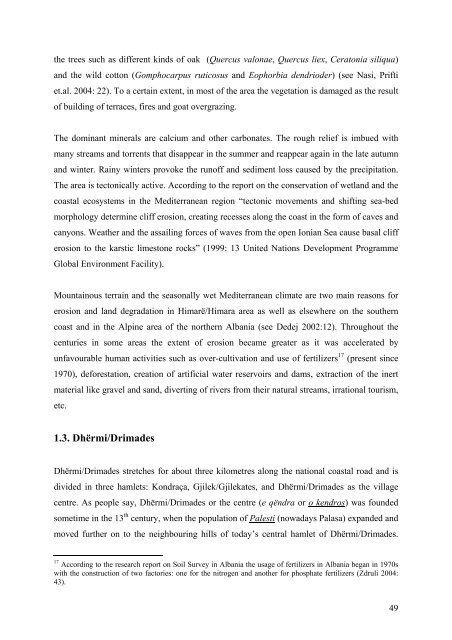university of nova gorica graduate school contested spaces and ...
university of nova gorica graduate school contested spaces and ...
university of nova gorica graduate school contested spaces and ...
You also want an ePaper? Increase the reach of your titles
YUMPU automatically turns print PDFs into web optimized ePapers that Google loves.
the trees such as different kinds <strong>of</strong> oak (Quercus valonae, Quercus liex, Ceratonia siliqua)<br />
<strong>and</strong> the wild cotton (Gomphocarpus ruticosus <strong>and</strong> Eophorbia dendrioder) (see Nasi, Prifti<br />
et.al. 2004: 22). To a certain extent, in most <strong>of</strong> the area the vegetation is damaged as the result<br />
<strong>of</strong> building <strong>of</strong> terraces, fires <strong>and</strong> goat overgrazing.<br />
The dominant minerals are calcium <strong>and</strong> other carbonates. The rough relief is imbued with<br />
many streams <strong>and</strong> torrents that disappear in the summer <strong>and</strong> reappear again in the late autumn<br />
<strong>and</strong> winter. Rainy winters provoke the run<strong>of</strong>f <strong>and</strong> sediment loss caused by the precipitation.<br />
The area is tectonically active. According to the report on the conservation <strong>of</strong> wetl<strong>and</strong> <strong>and</strong> the<br />
coastal ecosystems in the Mediterranean region “tectonic movements <strong>and</strong> shifting sea-bed<br />
morphology determine cliff erosion, creating recesses along the coast in the form <strong>of</strong> caves <strong>and</strong><br />
canyons. Weather <strong>and</strong> the assailing forces <strong>of</strong> waves from the open Ionian Sea cause basal cliff<br />
erosion to the karstic limestone rocks” (1999: 13 United Nations Development Programme<br />
Global Environment Facility).<br />
Mountainous terrain <strong>and</strong> the seasonally wet Mediterranean climate are two main reasons for<br />
erosion <strong>and</strong> l<strong>and</strong> degradation in Himarë/Himara area as well as elsewhere on the southern<br />
coast <strong>and</strong> in the Alpine area <strong>of</strong> the northern Albania (see Dedej 2002:12). Throughout the<br />
centuries in some areas the extent <strong>of</strong> erosion became greater as it was accelerated by<br />
unfavourable human activities such as over-cultivation <strong>and</strong> use <strong>of</strong> fertilizers 17 (present since<br />
1970), deforestation, creation <strong>of</strong> artificial water reservoirs <strong>and</strong> dams, extraction <strong>of</strong> the inert<br />
material like gravel <strong>and</strong> s<strong>and</strong>, diverting <strong>of</strong> rivers from their natural streams, irrational tourism,<br />
etc.<br />
1.3. Dhërmi/Drimades<br />
Dhërmi/Drimades stretches for about three kilometres along the national coastal road <strong>and</strong> is<br />
divided in three hamlets: Kondraça, Gjilek/Gjilekates, <strong>and</strong> Dhërmi/Drimades as the village<br />
centre. As people say, Dhërmi/Drimades or the centre (e qëndra or o kendros) was founded<br />
sometime in the 13 th century, when the population <strong>of</strong> Palesti (nowadays Palasa) exp<strong>and</strong>ed <strong>and</strong><br />
moved further on to the neighbouring hills <strong>of</strong> today’s central hamlet <strong>of</strong> Dhërmi/Drimades.<br />
17 According to the research report on Soil Survey in Albania the usage <strong>of</strong> fertilizers in Albania began in 1970s<br />
with the construction <strong>of</strong> two factories: one for the nitrogen <strong>and</strong> another for phosphate fertilizers (Zdruli 2004:<br />
43).<br />
49

















